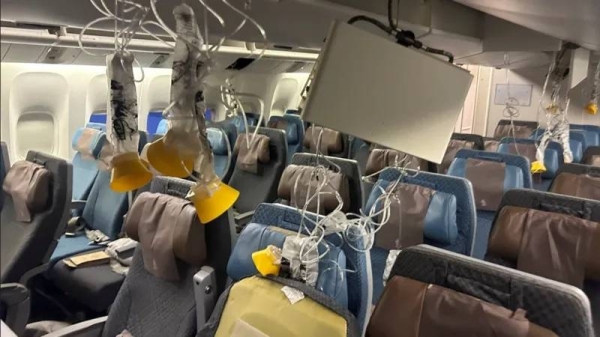Severe turbulence struck a Singapore Airlines flight, causing chaos and injury among passengers. A 73-year-old British man died from a suspected heart attack, while more than 30 people were injured as objects and people were launched across the cabin during the London-Singapore flight. Witnesses described the terrifying experience of the sudden drop and the aftermath of the turbulence. The Boeing 777-300ER diverted to Bangkok for an emergency landing, with 31 people taken to the hospital. The airline offered its condolences to the family of the deceased passenger and provided assistance to those affected.
Passengers on the flight recounted scenes of “absolute terror” as the turbulence hit unexpectedly. The incident caused panic and chaos in the cabin, with objects flying through the air and passengers being launched into the ceiling. Some sustained injuries from hitting their heads on overhead compartments and other cabin fixtures. The sudden drop during the meal service caught everyone by surprise, leading to a dramatic and frightening experience for all on board.
The Singapore-bound flight encountered the turbulence over Myanmar’s Irrawaddy Basin at 37,000 feet, prompting the emergency landing in Bangkok. The airline worked with Thai authorities to provide medical assistance to passengers and sent a team to offer additional support. Nationalities of passengers were revealed, with 47 from the UK, including individuals who shared their harrowing experiences during the turbulence. Family members received distressing messages from their loved ones on the flight, causing anxiety and fear for their safety.
As the flight diverted and made an emergency landing in Bangkok, passengers like Josh and Allison Barker experienced moments of uncertainty and fear. Josh recounted his ordeal on the plane, while his mother waited anxiously for updates on his condition. The experience left lasting impacts on passengers like Jerry, who sustained injuries during the turbulence. The sudden plunge of the plane left many shaken and traumatized, highlighting the dangers of severe turbulence and the importance of safety measures onboard flights.
Aviation experts emphasized the rarity of injuries from severe turbulence but acknowledged the potential for serious consequences. Climate change has been linked to an increase in severe turbulence, making it a growing concern for aviation safety. Flight crews are trained to respond to turbulence, and passengers are advised to keep seatbelts fastened at all times. Turbulence caused by clear air can be particularly dangerous as it is not visible on weather radar, posing risks to unsecured items and passengers during flights.
The incident on the Singapore Airlines flight serves as a sobering reminder of the unpredictable nature of air travel and the importance of safety precautions. Passengers and crew faced a terrifying ordeal as severe turbulence shook the plane, leading to injuries and a tragic loss of life. The response to the incident highlighted the need for preparedness and vigilance when flying, as well as the potential impacts of climate change on flight safety. As investigations continue into the cause of the turbulence, the aviation industry must prioritize passenger safety and well-being to prevent such incidents in the future.











